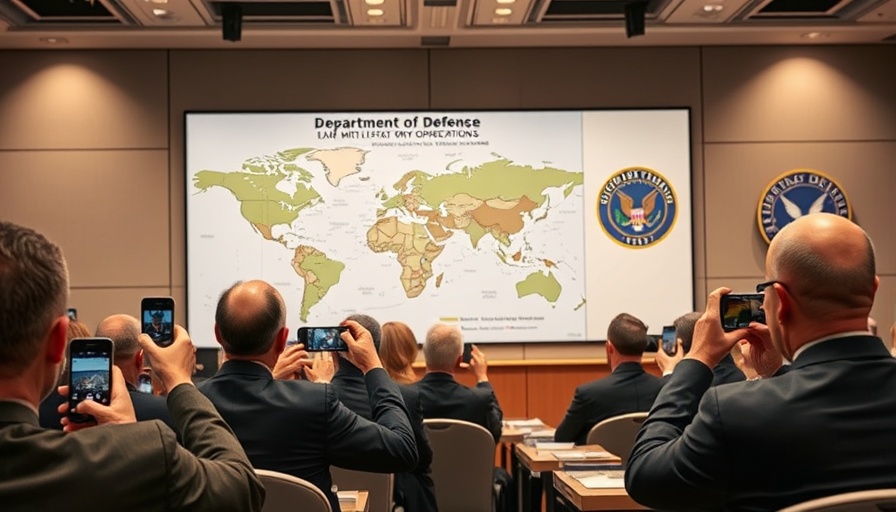
Unpacking Operation Midnight Hammer: A Major U.S. Military Action
On June 22, 2025, the Pentagon unveiled a meticulously planned military operation dubbed Operation Midnight Hammer, aimed at neutralizing Iran's nuclear threat. This highly secretive mission deployed B-2 stealth bombers on a groundbreaking 7,000-mile journey to bomb critical nuclear sites in Iran, forever shifting the landscape of U.S. foreign policy in the Middle East. Here, we examine the timeline and implications of this historic event.
The Attack Timeline: Critical Minutes
The military's timeline details a strikingly swift operation that highlights the precision and capability of modern aerial combat technology. The B-2 bombers took off from Whiteman Air Force Base in Missouri, traveling for almost 18 hours, refueled multiple times along the way, before entering Iranian airspace. Their first targets included the nuclear facilities at Fordo and Natanz, where they executed their strikes with precision-guided munitions such as the Massive Ordnance Penetrator, a bomb specifically designed for hitting deep underground targets.
International Reactions to U.S. Action
The immediate aftermath of the strikes has prompted varied global reactions. While some U.S. allies have expressed support for the action, emphasizing the necessity to curtail a nuclear-enhanced Iran, critics have condemned the strikes as an escalation of military conflicts in an already volatile region. This operation raises significant questions about American interventionism and the ethical implications of preemptive military strikes, especially given the humanitarian consequences that may ensue.
What It Means for National Security and Future Policy
Operation Midnight Hammer's implications extend beyond immediate military results, triggering extensive discussions about U.S. national security policies. The Pentagon's actions reinvigorate debates about military engagement and its efficacy as a political tool. The objective to dismantle Iran's nuclear capabilities underscores a continued commitment to interventionist foreign policy, reminiscent of past conflicts that shaped the Middle East. Is this a turning point for U.S. military strategy, or merely a continuation of existing paradigms?
Public and Political Responses
The strikes have stirred a profound reaction at home, drawing responses from various political figures and agencies. President Trump announced the successful operation via social media, framing it as a decisive victory in the fight against nuclear proliferation. As more details unfold, Congress gears up for debates on the implications of the strikes, weighing them against issues of military funding, oversight, and the potential need for legislative approvals for future military actions.
Global Context and Historical Precedence
Understanding Operation Midnight Hammer requires a lens that encompasses historical contexts of U.S. military actions abroad. This isn't the first time the U.S. has conducted military operations to preempt perceived threats; however, the nuance of nuclear capabilities adds a layer of urgency seldom seen in past operations. The strategy mirrors approaches taken during significant past conflicts, leading to a discourse on whether similar strategies will be utilized again in the future.
A Future Redefined: Predictions and Considerations
As this operation reverberates through both national and international walls, the future trajectory hinges on how the U.S. chooses to respond to the consequent fallout. Will this aggressive stance lead to a new framework for U.S.-Iran relations, or will it exacerbate tensions that could lead to further conflict? Analysts posit that the effectiveness of this operation might redefine deterrence strategies and influence how future administrations approach foreign policy in volatile regions.
The Information You Need
For those keenly interested in the implications of these military actions, staying informed will be critical. In an age where national security can pivot on a single decision, understanding the evolving landscape of U.S. military tactics and their ramifications on global politics is essential. Watch for news updates as Congress evaluates the attack and as military experts analyze its long-term effects. Understanding these developments can empower citizens to engage in informed discussions about American foreign policy and military strategy.
In conclusion, Operation Midnight Hammer marks a pivotal moment in U.S.-Iran relations and military strategy. As we navigate the complexities of international diplomacy, the importance of informed discourse cannot be overstated. Every citizen should be attuned to how these events unfold and consider their implications for the future.
 Add Element
Add Element  Add Row
Add Row 



 Add Row
Add Row  Add
Add 


Write A Comment